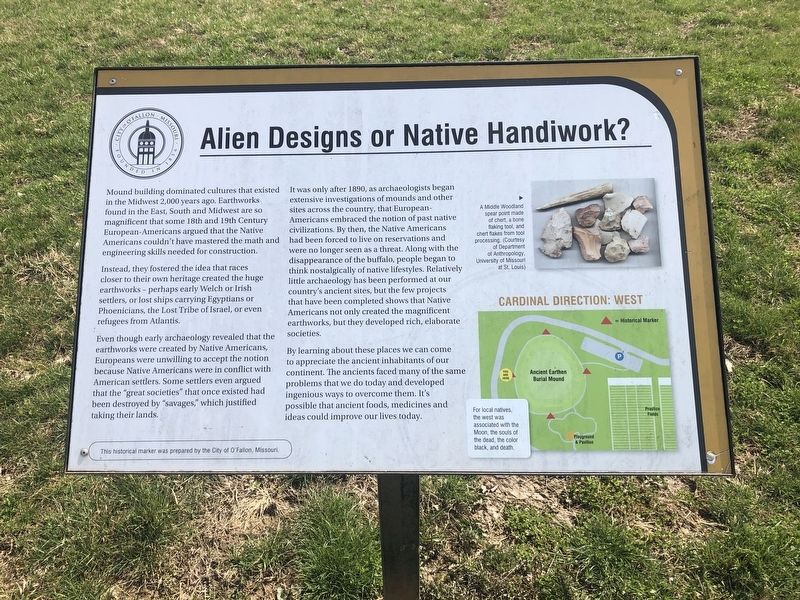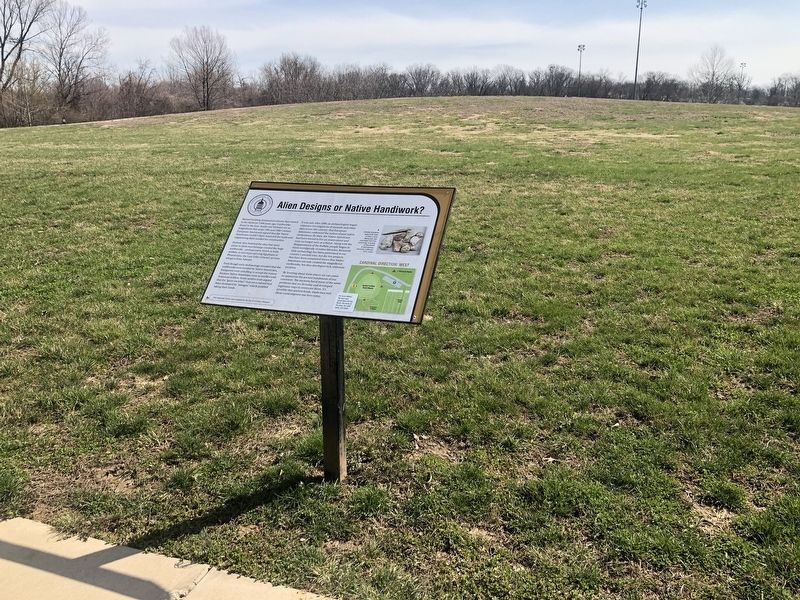Alien Designs or Native Handiwork?
City of O'Fallon, Missouri, founded in 1856

Mound building dominated cultures that existed in the Midwest 2,000 years ago. Earthworks found in the East, South and Midwest are so magnificent that some 18th and 19th Century European-Americans argued that the Native Americans couldn't have mastered the math and engineering skills needed for construction.
Instead, they fostered the idea that races closer to their own heritage created the huge earthworks — perhaps early Welch or Irish settlers, or lost ships carrying Egyptians or Phoenicians, the Lost Tribe of Israel, or even refugees from Atlantis.
Even though early archaeology revealed that the earthworks were created by Native Americans, Europeans were unwilling to accept the notion because Native Americans were in conflict with American settlers. Some settlers even argued that the "great societies" that once existed had been destroyed by "savages," which justified taking their lands.
It was only after 1890, as archaeologists began extensive investigations of mounds and other sites across the country, that European-Americans embraced the notion of past native civilizations. By then, the Native Americans had been forced to live on reservations and were no longer seen as a threat. Along with the disappearance of the buffalo, people began to think nostalgically of native lifestyles. Relatively little archaeology
has been performed at our country's ancient sites, but the few projects that have been completed shows that Native Americans not only created the magnificent earthworks, but they developed rich, elaborate societies.By learning about these places we can come to appreciate the ancient inhabitants of our continent. The ancients faced many of the same problems that we do today and developed ingenious ways to overcome them. It's possible that ancient foods, medicines and ideas could improve our lives today.
[Captions:]
Cardinal Direction: West
For local natives, the west was associated with the Moon, the souls of the dead, the color black, and death.
Erected by the City of O'Fallon, Missouri.
Topics. This historical marker is listed in these topic lists: Anthropology & Archaeology • Native Americans • Settlements & Settlers. A significant historical year for this entry is 1890.
Location. 38° 49.57′ N, 90° 42.624′ W. Marker is in O'Fallon, Missouri, in St. Charles County. Marker is on Dames Park Drive, 0.7 miles south of State Highway P, on the left when traveling south. Touch for map. Marker is at or near this postal address: 387 Dames Park Dr, O Fallon MO 63366, United States of America. Touch for directions.
Other nearby markers. At least 8 other markers are within 2 miles of this marker, measured as the crow flies. O'Fallon During Ancient Times (within shouting distance of this marker);

Additional commentary.
1. Ethnoracial Bias in the marker verbiage
While the marker interprets past biases in archaeology, the marker's wording reveals a potential bias in its own language. The third paragraph, the statement "...because Native Americans were in conflict with American settlers" is possibly biased.
While American is the demonym for citizens of the United States of America, it is also the demonym for any person who is a resident of the American continent(s), regardless of regardless of racial construct. In the United States of America, we divide America between North and South (and even further separation of Central America from North America), again regardless of racial construct.
The author of the text likely meant that Native Americans were in conflict with European settlers (or possibly of American-born settlers of European descent). To state that Native Americans were in conflict with Americans is an accidental tautology -- Native Americans, almost by definition, are Americans (except in the case of a person with indigenous American heritage not having citizenship of a country in the Americas).
Additional keywords. racism, Eurocentrism
Credits. This page was last revised on March 27, 2021. It was originally submitted on March 27, 2021, by Devry Becker Jones of Washington, District of Columbia. This page has been viewed 227 times since then and 30 times this year. Photos: 1, 2. submitted on March 27, 2021, by Devry Becker Jones of Washington, District of Columbia.